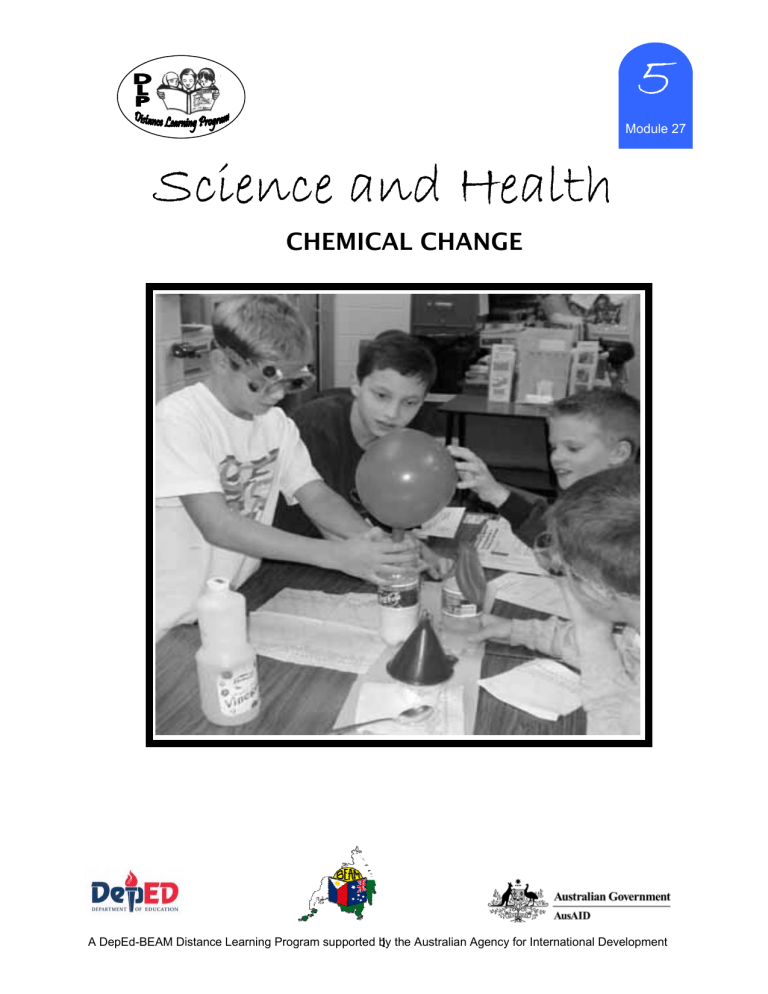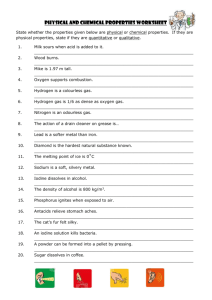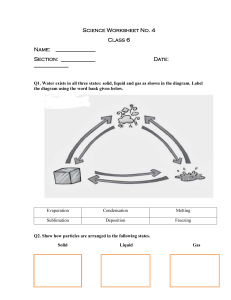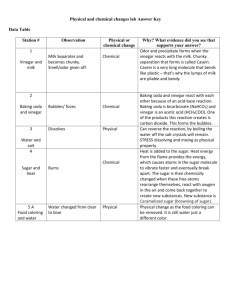Chemical Change Worksheet for Elementary School
advertisement

5 Module 27 Science and Health CHEMICAL CHANGE A DepEd-BEAM Distance Learning Program supported by 1 the Australian Agency for International Development To the Learner Dear Learner, Hi! Good day kid! How are you feeling today? Let’s have fun in studying the changes that happened around us. Let’s Learn This Materials undergo certain changes. There are two kinds of changes that the material undergoes. The physical change that you have learned in the previous lesson and the chemical change. Chemical change is too different from the physical change. The conditions needed, its effect and the products produce make it different. Let’s Try This Put √ on the space provided for under the picture if it shows chemical change and X if it’s not. 1. 3. 4. Broken bottle _________ Burning wood ________ 5. 2. Rotten apple ________ Melted ice ________ Folded paper ________ 82 Let’s Study This Chemical change is a change that involves the transformation of a material into a new substance. The new substance formed has different characteristics than the original substance. Certain conditions needed for a chemical change to happen. These are the application of heat or with a change in temperature and the addition of chemicals such as acids. When you burn the paper, the original characteristics of the paper changes. When paper is burned, heat, light, carbon dioxide, water vapor, and ashes are produced. The application of heat is the condition that causes the materials to change When eggshell was pounded into pieces, it changed in size and shape. However, when vinegar, a kind of acid, was added to the broken pieces of eggshell, bubbles were produced. The formation of bubbles indicated that carbon dioxide was released in the air. Carbon dioxide, a new substance, was formed due to the action of an acid like vinegar. The addition of chemical which is the acid is the condition that causes the materials to change. Other examples of chemical changes are the following: a. b. c. d. When fruit juice becomes vinegar or alcohol. The banana turns sweet. Ripening of fruits. When carbon dioxide gas and water becomes food in the leaves of a plant (photosynthesis). 83 Let’s Do This Activity I I - Problem: What change happened to some solid? II – Materials: A piece of stick, match, sugar, lid of an infant formula can. Precaution : Learner, do not play with the match. Be careful in doing the activity. III – Procedure: 1. Describe the physical characteristics of stick and sugar. 2. Hold one end of the stick and burn the other end with the use of match. 3. Put a teaspoonful of white sugar on the lid of a formula can. 4. Burn the sugar over the flame of a lighted candle. Questions: 1. What was the color of the stick before you burned it? 2. What is the color now? 3. What happened to the stick? 5. What was the color of the sugar before you burned it? 84 6. Did the sugar change into something else? What was it? 7. What factors brought about such changes? 8. Can we return the original form of stick and sugar? Why? Activity II I – Problem: How does some solid change? II – Materials: empty eggshell, stone or hammer, saucer or plate. III – Procedure: 1. Pound an empty eggshell into small pieces using hammer or stone. 2. Place the pieces of eggshell on a saucer or plate. 3. Add a teaspoonful of vinegar into them. Questions: 1. What was formed when you add vinegar to the broken pieces of eggshell? 2. What does it show? 85 3. What factor brought about such changes? 4. What kind of change is it? Let’s Do More A. Put √ on the space provided if the material undergo chemical change and X if it does not undergo a chemical change. 1. rusted iron nail 2. cooked rice 3. molded clay 4. souring milk 5. rotten rat 6. melted ice 7. lighted candle 8. digesting food 9. crushed pineapple 10. ripening of mango B. Give the product or new substances form on the following chemical changes. 1. photosynthesis 2. burned wood 3. iron with water Let’s Remember This Chemical change is a change that involves the transformation of a material into a substance due to the action or presence of heat and other substances such as acid. 86 Let’s Test Ourselves Choose the letter of the correct answer. 1. Which of the following is an example of chemical change? a. drying clothes c. alcohol evaporates b. baking bread d. ground meat. 2. What is produced when wood is completely burned in open air? a. ash b. coal c. bubbles d. oxygen 3. What happens when iron combines with water? a. iron rust b. iron breaks c. iron hardens d. iron becomes brittle 4. Ana burned her scratch paper and it turned to ashes. What factor that caused the changes a. b. c. d. change of temperature the application of heat addition of chemicals the absence of heat 5. Spoiled food, ripening of fruits and souring of milk are examples of chemical change, there is a change in the composition of a material. Does burning of wood belong to this kind of change? a. b. c. d. No, because it is only a change in phase. No, because it is just a change in size and shape. Yes, because the composition of wood has changed. Yes, because the composition of wood is the same. 87 Science Fact File Chemical changes are useful at home and in many industries. Example of this is the making of cheese. Cheese is produced if you add vinegar to milk. 88 Answer Key Let’s Try this 1. X 2. X 3. √ 4. √ 5. X Let’s Do This Activity I 1. 2. 3. 4. 5. 6. 7. Brown Gray It turns to ashes White/Brown Black Yes, hardened by heat No, because the composition has changed and it produced a new substance that cannot be returned to its original form. Activity II 1. 2. 3. 4. It formed bubbles. It shows that the carbon dioxide is released in the air. The addition of chemicals (acid) A chemical change. Let’s Do More A 1. 2. 3. 4. √ X X √ 89 5. √ 6. X 7. √ 8. √ 9. X 10. √ B. 1. sugar 2. ashes 3. rust Let’s Test Ourselves 1. 2. 3. 4. 5. b a a b c 90



